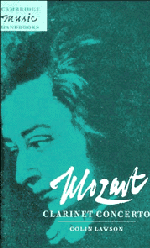Book contents
- Frontmatter
- Contents
- List of illustrations
- Preface
- 1 The eighteenth-century clarinet and its music
- 2 Mozart, Stadler and the clarinet
- 3 The genesis and reception of the Concerto
- 4 Stadler's clarinet and its revival
- 5 Mozart's original text
- 6 Design and structure
- 7 Performance practice
- Appendix 1 A review of the Breitkopf and Härtel edition in the Leipzig Allgemeine Musikalische Zeitung, 4 (March 1802)
- Appendix 2 Surviving instruments
- Appendix 3 A list of works composed by Mozart's clarinettist, Anton Stadler
- Notes
- Select bibliography
- Index
1 - The eighteenth-century clarinet and its music
Published online by Cambridge University Press: 05 June 2012
- Frontmatter
- Contents
- List of illustrations
- Preface
- 1 The eighteenth-century clarinet and its music
- 2 Mozart, Stadler and the clarinet
- 3 The genesis and reception of the Concerto
- 4 Stadler's clarinet and its revival
- 5 Mozart's original text
- 6 Design and structure
- 7 Performance practice
- Appendix 1 A review of the Breitkopf and Härtel edition in the Leipzig Allgemeine Musikalische Zeitung, 4 (March 1802)
- Appendix 2 Surviving instruments
- Appendix 3 A list of works composed by Mozart's clarinettist, Anton Stadler
- Notes
- Select bibliography
- Index
Summary
Origins and birth of the clarinet
It is a remarkable fact that little more than a hundred years before the composition of Mozart's Clarinet Concerto K622, there had yet been no inclusion of single-reed instruments in art music. Despite a long history in folk music, no evidence of clarinet-types in written scores occurs until just before 1700, and this accounts for the clarinet's reputation as the youngest member of the orchestral wind section. In fact, the baroque flute, oboe and bassoon had been developed not many years before, and were featured in the orchestra by Lully (1632–87); however, these instruments were more closely related to their antecedents, both in design and in musical usage.
The early years of the clarinet are especially relevant to a study of Mozart's Concerto, because the principal registers featured and contrasted so effectively within its solo part existed for many years as two distinctive instruments. The starting point for any discussion of the birth of the chalumeau and the clarinet remains J. G. Doppelmayr's Historische Nachricht von den Nürnbergischen Mathematicis und Kunstlern (Nuremberg, 1730), whose biography of the maker Johann Christoph Denner (1655–1707) contains the celebrated statement: ‘At the beginning of the current century, he invented a new kind of pipe-work, the so-called clarinet, to the great delight of all music-lovers, discovered again from ancient times the already well-known stick or rackett bassoon, and at length presented an improved chalumeau’.
- Type
- Chapter
- Information
- Mozart: Clarinet Concerto , pp. 1 - 13Publisher: Cambridge University PressPrint publication year: 1996



